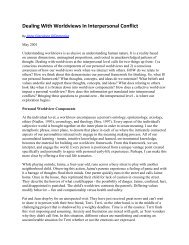the Facilitator Handbook - IDEA - U.S. Department of Education
the Facilitator Handbook - IDEA - U.S. Department of Education
the Facilitator Handbook - IDEA - U.S. Department of Education
- No tags were found...
Create successful ePaper yourself
Turn your PDF publications into a flip-book with our unique Google optimized e-Paper software.
DIALOGUE GUIDEFACILITATOR HANDBOOKteams would benefit and made a plan to talkto <strong>the</strong> administration about designating time forsuch dialogues. The teachers also felt that familieswould benefit from <strong>the</strong> dialogue. They beganplanning how <strong>the</strong>y might bring families into <strong>the</strong>dialogue. One suggestion was to talk with severalcommunity leaders about how to support participation.…A pr<strong>of</strong>essional organization decides to conducta dialogue on an emerging topic <strong>of</strong> interest toits membership as part <strong>of</strong> its state convention.Attendees generate several actions that <strong>the</strong> groupmight take—report to local chapters; hold localdialogues on <strong>the</strong> topic; survey <strong>the</strong> membershipfor input on <strong>the</strong> topic. Participants sign up fortasks. The facilitator agrees to coordinate followupactivities by posting all communications on<strong>the</strong> organization website and creating an electronicbulletin board that will allow participantsto keep in touch.A distinguishing feature <strong>of</strong> <strong>the</strong> Dialogue Guides is<strong>the</strong> focus on action. Fur<strong>the</strong>r dialogue depends on<strong>the</strong> participants. Participants are expected to takesome type <strong>of</strong> action that is based on what <strong>the</strong>y havelearned from <strong>the</strong> dialogue.Action can take many forms. For example, <strong>the</strong> dialoguecould lead to:• Increased perspective taking. <strong>Facilitator</strong>s canhelp by providing participants with opportunitiesto reflect on <strong>the</strong>ir experience (membersthink about how <strong>the</strong>ir perspective comparesto <strong>the</strong> perceptions <strong>of</strong> o<strong>the</strong>rs). Formalizing reflectiondemonstrates its importance and providesan impetus for participants to learn from<strong>the</strong> reflection <strong>of</strong> o<strong>the</strong>rs.• Development <strong>of</strong> new venues for more indepthand collaborative work. Discuss how<strong>the</strong> dialogue might be built into o<strong>the</strong>r ongoingactivities (e.g., in service, pr<strong>of</strong>essional development,or community capacity buildingopportunities). In some cases, participantsmay identify specific tasks to accomplish(e.g., collect information from <strong>the</strong>ir respectiveconstituents; organize a new group meeting).Suggest a follow-up activity (e.g., conferencecall, face-to-face meeting) in four tosix weeks. Invite participants to help you planit.• Recruitment <strong>of</strong> new audiences to <strong>the</strong> dialogue.Encourage a discussion about who elseshould have dialogue. Ask, “Who else needsto have this dialogue/who else should webring in?” Encourage participants to suggesthow to make it more likely that <strong>the</strong>se newpeople participate.Redirecting <strong>the</strong> Process asNeededComprehensive planning—making sure that all logisticshave been taken care <strong>of</strong>, that activities havebeen developed to support participation and thatpeople feel safe in sharing—can go a long way inensuring success. Through planning, facilitators areable to anticipate typical challenges and prepare appropriately.However, no matter how well you have planned,<strong>the</strong>re is always <strong>the</strong> possibility that <strong>the</strong> group willget <strong>of</strong>f track at some time. In many cases, <strong>the</strong> derailmentis only minor and <strong>the</strong> group recovers onits own. But, <strong>the</strong>re may be o<strong>the</strong>r times when groupmembers look to you as <strong>the</strong> facilitator to help get<strong>the</strong>m back on course.When <strong>the</strong> process veers <strong>of</strong>f course, you may find itnecessary to redirect <strong>the</strong> group. Following are severalsuggestions to consider:• Repeat directions. Keep in mind that dialoguewill be new to most people. In somecases, <strong>the</strong>re may be misunderstandings ormiscommunication regarding <strong>the</strong> purpose <strong>of</strong>dialogue. Sometimes it is necessary to repeatdirections periodically throughout <strong>the</strong> course<strong>of</strong> <strong>the</strong> dialogue. You may even want to checkparticipant understandings to ensure that everyoneis clear.<strong>IDEA</strong> Partnership .........................................................................................................................21
















